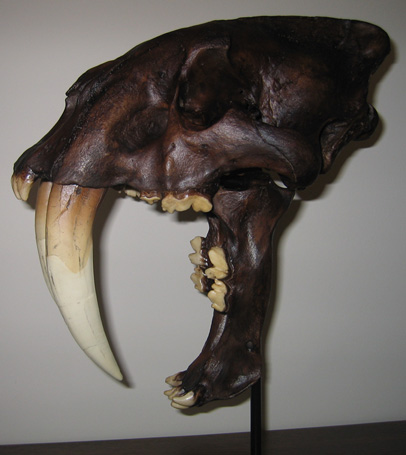A Confusing Name – The Sabre-Tooth Tiger
In episode three of Primeval (ITV1) being shown tomorrow (26th January), a Sabre-Tooth cat makes its debut on the show. It is seen stalking the poor visitors to a UK theme park, but not to worry the brave team of evolutionary zoologists are on their way to rescue the situation.
Sabre-Tooths are perhaps one of the best known prehistoric mammals, they feature regularly in our annual surveys into people’s most popular prehistoric animals. In fact, the Sabre-Tooth competes with the Woolly Mammoth for the most popular prehistoric mammal. In the last survey, this big cat just pipped the Mammoth and was number six on our top ten list.
Latest survey results: Best selling Prehistoric Animals 2007/8.
Often these animals are referred to as Sabre-Tooth Tigers, we do use this terminology in order to assist customers with queries and product searches but the name is confusing as Sabre-Tooths (genus name Smilodon), are not actually that closely related to Tigers.
The Skull of a Smilodon
The genus name – Smilodon means “knife tooth” in recognition of the large upper canines these animals possessed. In a large Smilodon; such as Smilodon fatalis, the upper canines could be up to 18 cm long. The jaws on Sabre-Tooth cats were specially adapted to open wide and could gape to 120° (an African lion can open its jaws to about 70°), this would have permitted Smilodon to close its jaws around the neck of its victim and puncture vital blood vessels to the brain and sever the windpipe leading to a quick kill. However, these teeth are quite delicate and could shatter if they bit down onto bone.
Smilodon (Sabre-toothed Cats)
As well as having huge canines, many Sabre-Tooth cats had protruding incisors at the front of the mouth. These seem to have been adapted for stripping meat off a carcase as the large Sabre-like teeth would have had limited use when feeding.
These animals spread over much of the world during the Pleistocene epoch, with the last of these magnificent predators dying out 10,000 years ago, perhaps as a result of the decline in large prey for them to hunt.
The size of a Sabre-Tooth cat depends on the individual species but estimates of a total body length of around 1.7 metres and a height at the shoulder of 1.2 metres have been given for Smilodon fatalis. Palaeontologists still debate the weight of these animals, they were stocky and very strong with powerful front limbs and shoulders – needed when it came to taking down large prey. Estimates vary but most authorities suggest a weight of around 300 kilogrammes for a large, adult Smilodon. In contrast, a fully grown, male African Lion (Panthera leo) might weigh between 180 to 240 kilogrammes.
To see a prehistoric animal models and toys: Everything Dinosaur.
“Sabre-toothed Tiger”
The popular name “Sabre-Tooth Tiger” is misleading. Smilodon was not closely related to modern Tigers, although they were members of the cat family – Felidae. The Sabre-Tooths belonged to a sub-family of the cats, called the Machairodonts which can be dated back to around 12 million years ago. None of us at Everything Dinosaur can recall when the term Sabre-Tooth Tiger came into use, but technically it is inaccurate to describe these extinct predators as “tigers”.
The famous Tar Pits of La Brea in Los Angeles have yielded some of the best preserved remains of Smilodon (mainly Smilodon californicus). Something like 162,000 Smilodon bones have been recovered, representing over 2,100 individuals. So numerous are Smilodon fossils that this big cat has been named the official state fossil for California. The tar pits form when crude oil seeps to the surface through fissures in the ground. Water tends to accumulate on these sticky deposits and luckless animals get trapped when they visit these pits for a drink. Hungry predators like Sabre-Tooths or Dire Wolves would have then got caught themselves as they closed in on the hapless animal. Expecting an easy meal but ending up stuck themselves.
Most Sabre-Tooths are depicted with a speckled or tan hide. They were not built for speed so they most likely ambushed prey. This colour scheme was incorporated into the Prehistoric Mammal soft toy depicting a Smilodon.
To see our range of prehistoric mammal plush: Prehistoric Animal Soft Toys.
Little is known about the social life of these big cats. It seems that unlike Lions the sexes were roughly the same size. This may have meant they had a different social order than Lions. From the injuries found on fossils it seems that they helped sick and wounded cats, hunting for them and providing food. It is likely they lived in family groups with a territory, but further research is required into this particular aspect of Smilodon’s behaviour.







Leave A Comment